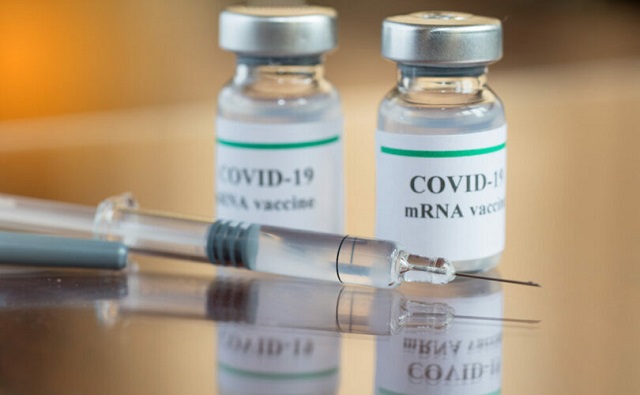COVID-19
COVID vaccine science catching up with ‘conspiracy theorists’

|
|||
| Dr. Raphael Lataster provides an update on the emerging peer-reviewed literature that continues to expand the data, analysis, and confirmation that the EUA/OWS mRNA vaccines were neither safe nor effective. Drs. Peter Marks, Robert Kadlec, NIH/NIAID VRC, Pfizer and Moderna were wrong to rush these products out while bypassing the accumulated regulatory and bioethics wisdom developed over decades. They must be held accountable. |
Raphael Lataster, PhD

Two new peer-reviewed medical journal articles indicate that the science is starting to catch up with the ‘conspiracy theorists’ and ‘anti-vaxxers’ such as myself, also known as people that rationally asked questions of novel products that were rushed out the door, to help stem a pandemic that was far less deadly than all other causes, including cardiovascular disease, cancer, and even tobacco use (and note that COVID-19 deaths tend to be inflated). Publishing in the Polish Annals of Medicine, Thoene conducts a limited literature review on the reporting of COVID-19 vaccine severe adverse events in scientific journals, finding:
“From 2020 to 2024, the literature has gone from claiming there are absolutely no SAEs from mRNA based vaccines (2020/2021) to an acknowledgment of a significant number of various SAEs (2023/2024); including but not limited to neurological complications, myocarditis, pericarditis and thrombosis. … The early scientific literature was biased, so as not to report SAEs, due to social and political concerns and overwhelming corporate greed. Only in the last year have scientists been able to publish articles that acknow- ledge a high number of SAEs linked to mRNA based vaccines. This should act as a warning that science should be completely objective when evaluating health risks, but can often be influenced by social and economic considerations.” Source.
Proving once again that Eastern Europeans are based (the Hungarians stand up to the EU on immigration [source], and the Bulgarians published my little study on the correlation between COVID-19 vaccination and European excess mortality), the Polish journal kindly accepted my brief response, entitled ‘Scientific views around mRNA based covid vaccines are changing, but to what end?’, praising them and Thoene for this important paper, and noting that this is only the tip of the iceberg. Source. There is so much more in the published science that most people are unaware of, such as:
- Thacker, on “issues such as data falsification and patient unblinding concerning Pfizer’s vaccine trial”.
- Fraiman et al., on the “excess risk of serious adverse events of special interest with the mRNA vaccines”.
- Benn et al., on there being “no statistically significant decrease in COVID-19 deaths in the mRNA vaccine clinical trials, while there was an increase (also not statistically significant) in total deaths”.
- The JECP4 articles by Doshi’s team and Lataster’s team (of one, because nobody likes me…) on “counting window issues (such as counting window delays, counting window biases, and counting window misclassifications), likely leading to exaggerated effectiveness and safety estimates” in the clinical trials and major observational studies, with one of the major problems being “when COVID-19 infections are being overlooked in the ‘partially vaccinated,’ and in some cases were even ascribed to unvaccinated groups”. Note that Mead et al. discussed some similar issues and yet was astonishingly retracted.
- Faksova et al., which Thoene barely mentioned, and which demonstrated that the vaccines are associated with several concerning adverse effects, despite employing a counting window endpoint of only 42 days following vaccination.
- Raethke et al., “which noted a rate of serious adverse drug reactions of approximately 1 per 400 people”, which I note compares “very unfavourably with UK government estimates on the numbers needed to vaccinate in young and healthy people to prevent a severe COVID-19 hospitalisation being in the hundreds of thousands”.
- Mostert et al., on the “mysterious problem of excess mortality post-pandemic, which they hint could be related to the COVID-19 vaccines”, and my aforementioned Bulgarian Medicine article demonstrating that there are indeed correlations between COVID-19 vaccination and European excess deaths.
- Of course, my ‘favourite’ topic, COVID-19 vaccine negative effectiveness, where “the vaccines increase the chance of COVID-19 infection, and even COVID-19 death, a ‘benefit’ which is of course a poor trade-off for the risk of (other) adverse effects”. This “led to some discussion in major medical journals such as the BMJ [and also AJGP], with the most common excuse for this phenomenon being that there must be some confounding variable at play”, an “excuse that somehow does not apply before vaccine effectiveness crosses the x-axis, indicating a clear double standard (one of many) in how the vaccines are evaluated”.
- Fürst et al. (those Eastern Europeans again!), on evidence “that a healthy vaccinee bias is at play”, which “would further imply that the effectiveness of the COVID-19 vaccines is being exaggerated, beyond the effects of counting window issues and other data manipulations, even when declining to zero and beyond”.
- The “substantive critiques appearing in influential medical journals of major observational studies purporting the benefits of the vaccines (with more on the way)”. These include my BMJ rapid response on the WHO’s jab study and the little academic debate between myself and a team from Johns Hopkins. Much more coming soon…
Still wondering how I managed to get this published, I end with a stark warning for those who partook in the deadly con:
“There is clearly much research on the COVID-19 vaccines, published in the biggest medical journals, which greatly contradict the mainstream and early, as well as ongoing, claims concerning their safety and effectiveness, and even necessity, for all. There is much more not mentioned in this brief article, and there is no doubt more to come. It seems obvious to me, that at least for the young and healthy, COVID-19 vaccines are most certainly not worth the risk, even when considering just a single adverse effect (myocarditis), no matter how rare it is purported to be – serious COVID-19 in the young and healthy is rarer still, and the same is even more true when considering the little to no benefits offered by what increasingly appears to be a feckless vaccine.
There have already been many legal actions, including victories (as with myself), initiated on behalf of the (somehow still alive) unvaccinated who were persecuted over a pharmaceutical product that they clearly did not need, and the vaccinated who have died and otherwise been injured as a result of vaccination. I anticipate that many more lawsuits are on the horizon, involving – amongst others – the vaccine manufacturers; the government officials that approved, encouraged, and even mandated the vaccines; and the many doctors and scientists who effectively betrayed their professions and public trust in encouraging the use of these flawed products based on very limited and even manipulated scientific evidence.”
Of course, while the science is starting to catch up, and the lawsuits are continuing apace (source), we’re still being told by our governments and mainstream media to roll up our sleeves, even those of us as young as 6 months. Source and source.
Okay then.
Okay Then News (and the associated forum at CovidSkeptics.com) is my personal collection of evidences against mainstream narratives, made freely available to the public. Subscribe for free email updates, here.
If you wish to donate or support me, as I fight for our rights, including doing the necessary research, and attempt to pick up the pieces after they took everything from me (and continue to), you can sign up for a voluntary paid subscription, here.
COVID-19
New report warns Ottawa’s ‘nudge’ unit erodes democracy and public trust

The Justice Centre for Constitutional Freedoms has released a new report titled Manufacturing consent: Government behavioural engineering of Canadians, authored by veteran journalist and researcher Nigel Hannaford. The report warns that the federal government has embedded behavioural science tactics in its operations in order to shape Canadians’ beliefs, emotions, and behaviours—without transparency, debate, or consent.
The report details how the Impact and Innovation Unit (IIU) in Ottawa is increasingly using sophisticated behavioural psychology, such as “nudge theory,” and other message-testing tools to influence the behaviour of Canadians.
Modelled after the United Kingdom’s Behavioural Insights Team, the IIU was originally presented as an innocuous “innovation hub.” In practice, the report argues, it has become a mechanism for engineering public opinion to support government priorities.
With the arrival of Covid, the report explains, the IIU’s role expanded dramatically. Internal government documents reveal how the IIU worked alongside the Public Health Agency of Canada to test and design a national communications strategy aimed at increasing compliance with federal vaccination and other public health directives.
Among these strategies, the government tested fictitious news reports on thousands of Canadians to see how different emotional triggers would help reduce public anxiety about emerging reports of adverse events following immunization. These tactics were designed to help achieve at least 70 percent vaccination uptake, the target officials associated with reaching “herd immunity.”
IIU techniques included emotional framing—using fear, reassurance, or urgency to influence compliance with policies such as lockdowns, mask mandates, and vaccine requirements. The government also used message manipulation by emphasizing or omitting details to shape how Canadians interpreted adverse events after taking the Covid vaccine to make them appear less serious.
The report further explains that the government adopted its core vaccine message—“safe and effective”—before conclusive clinical or real-world data even existed. The government then continued promoting that message despite early reports of adverse reactions to the injections.
Government reliance on behavioural science tactics—tools designed to steer people’s emotions and decisions without open discussion—ultimately substituted genuine public debate with subtle behavioural conditioning, making these practices undemocratic. Instead of understanding the science first, the government focused primarily on persuading Canadians to accept its narrative. In response to these findings, the Justice Centre is calling for immediate safeguards to protect Canadians from covert psychological manipulation by their own government.
The report urges:
- Parliamentary oversight of all behavioural science uses within federal departments, ensuring elected representatives retain oversight of national policy.
- Public disclosure of all behavioural research conducted with taxpayer funds, creating transparency of government influence on Canadians’ beliefs and decisions.
- Independent ethical review of any behavioural interventions affecting public opinion or individual autonomy, ensuring accountability and informed consent.
Report author Mr. Hannaford said, “No democratic government should run psychological operations on its own citizens without oversight. If behavioural science is being used to influence public attitudes, then elected representatives—not unelected strategists—must set the boundaries.”
COVID-19
Freedom Convoy protestor Evan Blackman convicted at retrial even after original trial judge deemed him a “peacemaker”

Evan Blackman and his son at a hockey game
The Justice Centre for Constitutional Freedoms announces that peaceful Freedom Convoy protestor Evan Blackman has been convicted of mischief and obstructing a peace officer at the conclusion of his retrial at the Ontario Court of Justice, despite being fully acquitted on these charges at his original trial in October 2023.
The Court imposed a conditional discharge, meaning Mr. Blackman will have no jail time and no criminal record, along with 12 months’ probation, 122 hours of community service, and a $200 victim fine surcharge.
The judge dismissed a Charter application seeking to have the convictions overturned on the basis of the government freezing his bank accounts without explanation amid the Emergencies Act crackdown in 2022.
Lawyers funded by the Justice Centre had argued that Mr. Blackman acted peacefully during the enforcement action that followed the federal government’s February 14, 2022, invocation of the Emergencies Act. Drone footage entered as evidence showed Mr. Blackman deescalating confrontations, raising his hand to keep protestors back, and kneeling in front of officers while singing “O Canada.” The original trial judge described Mr. Blackman as a “peacemaker,” and acquitted him on all charges, but the Crown challenged that ruling, resulting in the retrial that has now led to his conviction.
Mr. Blackman was first arrested on February 18, 2022, during the police action to clear protestors from downtown Ottawa. Upon his release that same day, he discovered that three of his personal bank accounts had been frozen under the Emergency Economic Measures Order. RCMP Assistant Commissioner Michel Arcand later confirmed that 257 bank accounts had been frozen nationwide under the Emergencies Act.
Constitutional lawyer Chris Fleury said, “While we are relieved that Mr. Blackman received a conditional discharge and will not carry a criminal record, we remain concerned that peaceful protestors continue to face disproportionate consequences stemming from the federal government’s response in February 2022.”
“We are disappointed that the Court declined to stay Mr. Blackman’s convictions, which are tainted by the serious infringements of his Charter-protected rights. Mr. Blackman is currently assessing whether he will be appealing this finding,” he added.
-

 Health2 days ago
Health2 days agoCDC’s Autism Reversal: Inside the Collapse of a 25‑Year Public Health Narrative
-

 Crime2 days ago
Crime2 days ago‘Modern-Day Escobar’: U.S. Says Former Canadian Olympian Ran Cocaine Pipeline with Cartel Protection and a Corrupt Toronto Lawyer
-

 Crime2 days ago
Crime2 days agoCocaine, Manhunts, and Murder: Canadian Cartel Kingpin Prosecuted In US
-

 Health2 days ago
Health2 days agoBREAKING: CDC quietly rewrites its vaccine–autism guidance
-

 Alberta1 day ago
Alberta1 day agoPremier Smith explains how private clinics will be introduced in Alberta
-

 Opinion2 days ago
Opinion2 days agoLandmark 2025 Study Says Near-Death Experiences Can’t Be Explained Away
-

 Focal Points2 days ago
Focal Points2 days agoSTUDY: TikTok, Instagram, and YouTube Shorts Induce Measurable “Brain Rot”
-

 Censorship Industrial Complex1 day ago
Censorship Industrial Complex1 day agoUK Government “Resist” Program Monitors Citizens’ Online Posts







